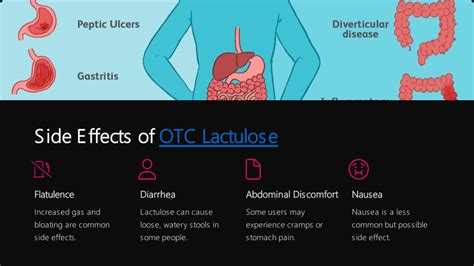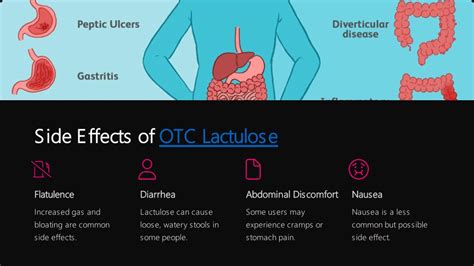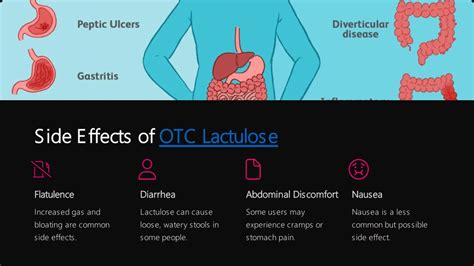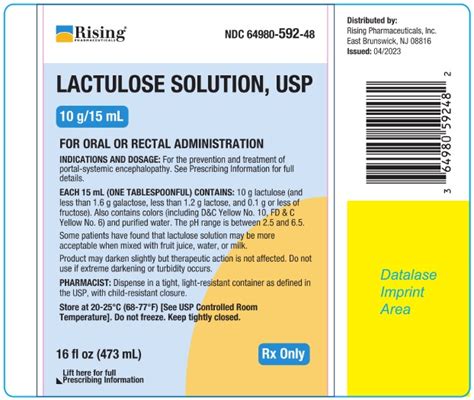Intro
Discover the potential risks of lactulose, including common side effects like bloating, gas, and stomach cramps, as well as rare complications, to ensure safe treatment for constipation and liver disease.
The importance of understanding lactulose side effects cannot be overstated, especially for individuals who rely on this medication to manage certain health conditions. Lactulose is a synthetic sugar used primarily in the treatment of constipation and hepatic encephalopathy, a condition where the liver is unable to remove toxins from the blood, leading to brain dysfunction. While lactulose can be highly effective in treating these conditions, it is crucial for patients to be aware of the potential side effects associated with its use. This knowledge enables them to recognize and manage any adverse reactions promptly, ensuring the safe and effective use of the medication.
Lactulose works by drawing water into the bowel from the surrounding body tissues, allowing for softer stools and making it easier to pass bowel movements. In the case of hepatic encephalopathy, lactulose helps by reducing the production of ammonia in the gut, which is a toxin that can affect brain function. Despite its benefits, the use of lactulose can lead to several side effects, ranging from mild to severe. Understanding these side effects is vital for maintaining the quality of life for individuals undergoing treatment with lactulose.
The management of lactulose side effects is a critical aspect of patient care. Healthcare providers play a significant role in educating patients about what to expect during treatment and how to mitigate any adverse effects. Patients, too, must be proactive in monitoring their health and reporting any changes or concerns to their healthcare provider. By working together, it is possible to minimize the impact of lactulose side effects and maximize the benefits of the medication. This article aims to provide a comprehensive overview of the common and less common side effects associated with lactulose, as well as guidance on managing these effects and improving treatment outcomes.
Lactulose and Its Common Side Effects

Understanding Gastrointestinal Side Effects
To manage gastrointestinal side effects effectively, it is essential to understand their causes. The fermentation process that lactulose undergoes in the gut can lead to the production of gas, causing bloating and discomfort. Eating smaller, more frequent meals and avoiding gas-producing foods can help reduce these symptoms. Additionally, staying hydrated by drinking plenty of water can help soften stool and make it easier to pass, potentially reducing the need for high doses of lactulose.Less Common but Significant Side Effects

Electrolyte Imbalance and Its Implications
Electrolytes, such as potassium, play a crucial role in various bodily functions, including nerve and muscle function. An imbalance can lead to serious health issues if not addressed promptly. Patients undergoing lactulose treatment should be vigilant about monitoring their electrolyte levels, especially if they are also taking other medications that can affect electrolyte balance. Dietary adjustments, such as increasing potassium-rich foods, can help maintain healthy electrolyte levels, but in some cases, supplementation under medical guidance may be necessary.Special Considerations and Precautions

Pregnancy, Breastfeeding, and Lactulose Use
The decision to use lactulose during pregnancy or breastfeeding should be made under the guidance of a healthcare provider. While lactulose is generally considered safe, its use in these situations requires careful consideration of the potential benefits and risks. In some cases, alternative treatments may be recommended to manage constipation or hepatic encephalopathy, especially if the condition is mild.Managing Lactulose Side Effects: Tips for Patients

Dietary Adjustments for Lactulose Users
Diet plays a significant role in managing lactulose side effects. A balanced diet rich in fruits, vegetables, and whole grains can help regulate bowel movements and reduce the reliance on laxatives. Avoiding foods that can exacerbate bloating, such as beans, cabbage, and broccoli, may also be beneficial for some individuals. However, it is essential to ensure that any dietary changes are made under the guidance of a healthcare provider to avoid any adverse effects on overall health or the effectiveness of the lactulose treatment.Conclusion and Future Directions

Looking Ahead: Advancements in Lactulose Therapy
The future of lactulose therapy holds promise for improved treatment options with reduced side effects. Ongoing research into the mechanisms of lactulose action and its impact on gut health may lead to the development of more targeted therapies. Additionally, advancements in drug delivery systems could potentially reduce the gastrointestinal side effects associated with lactulose, making it a more tolerable option for patients. As healthcare continues to evolve, the management of lactulose side effects will remain a critical area of focus, ensuring that patients receive the most effective treatment possible while maintaining their quality of life.What are the most common side effects of lactulose?
+The most common side effects of lactulose include bloating, gas, stomach cramps, and diarrhea. These are usually mild and temporary but can be uncomfortable.
Can lactulose cause an allergic reaction?
+Yes, lactulose can cause an allergic reaction in some individuals. Signs of an allergic reaction include hives, itching, swelling, and difficulty breathing. If you experience any of these symptoms, seek medical help immediately.
How can I manage lactulose side effects?
+To manage lactulose side effects, start with a low dose and gradually increase it as needed, maintain a high-fiber diet, drink plenty of water, and engage in regular physical activity. You can also consider taking simethicone for gas relief. Always consult your healthcare provider for personalized advice.
We invite you to share your experiences or ask questions about lactulose side effects in the comments below. Your input can help others better understand and manage their treatment. If you found this article informative, please consider sharing it with others who might benefit from this information. Together, we can work towards improving healthcare outcomes for everyone.
